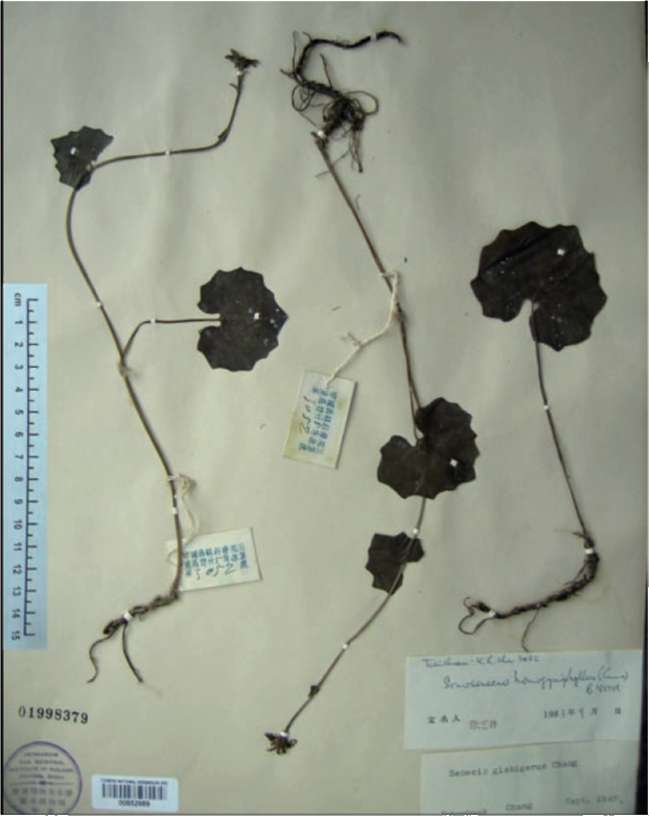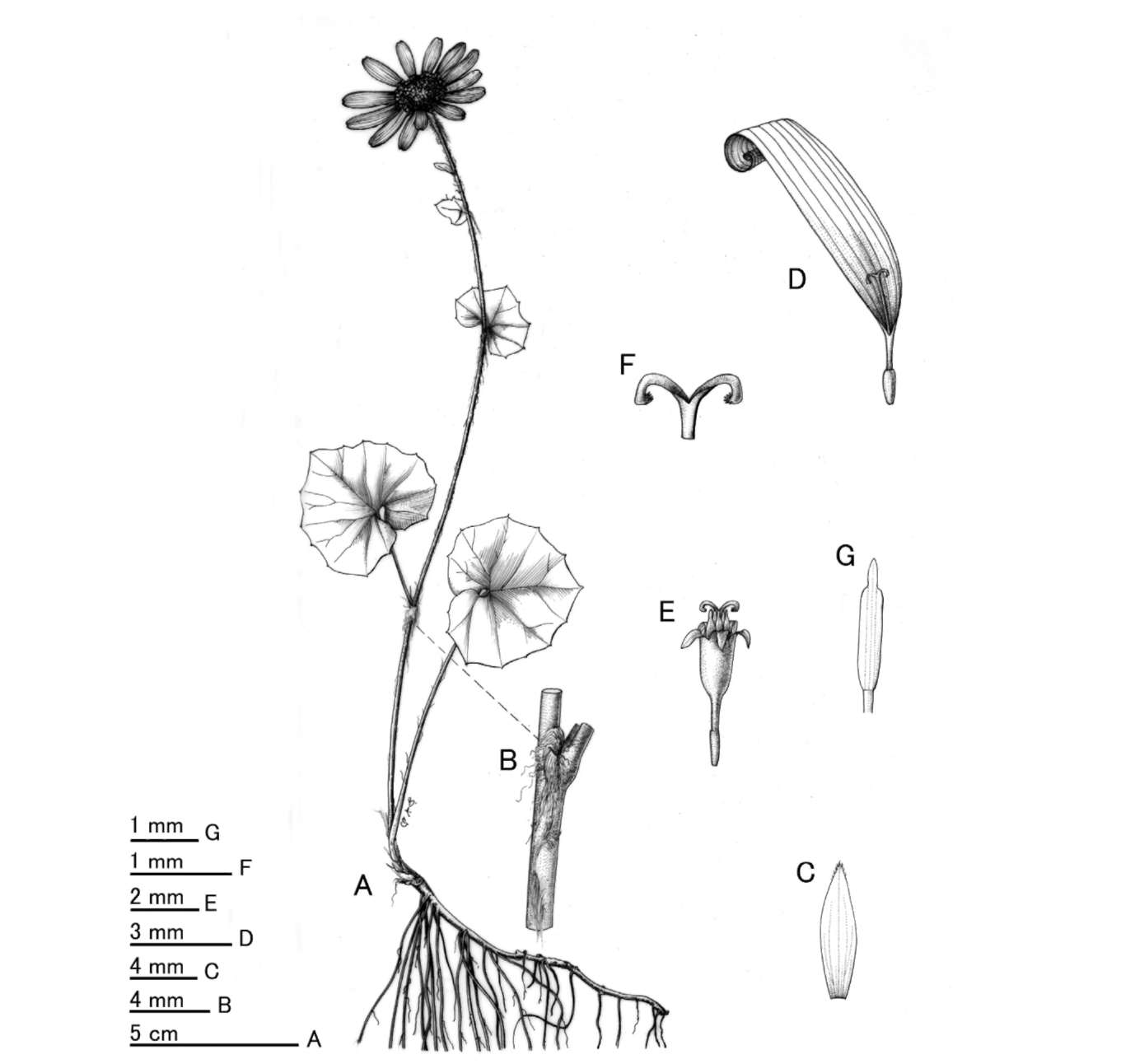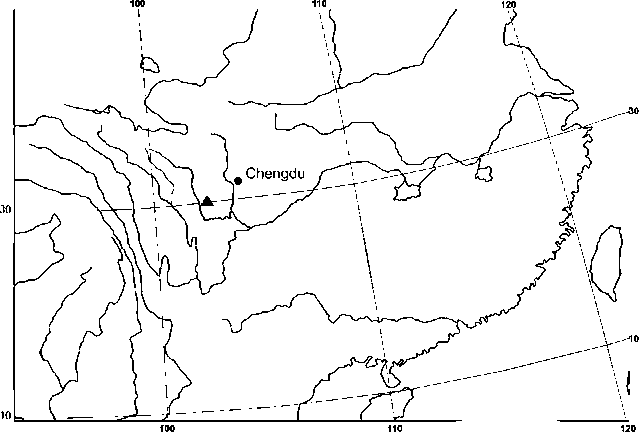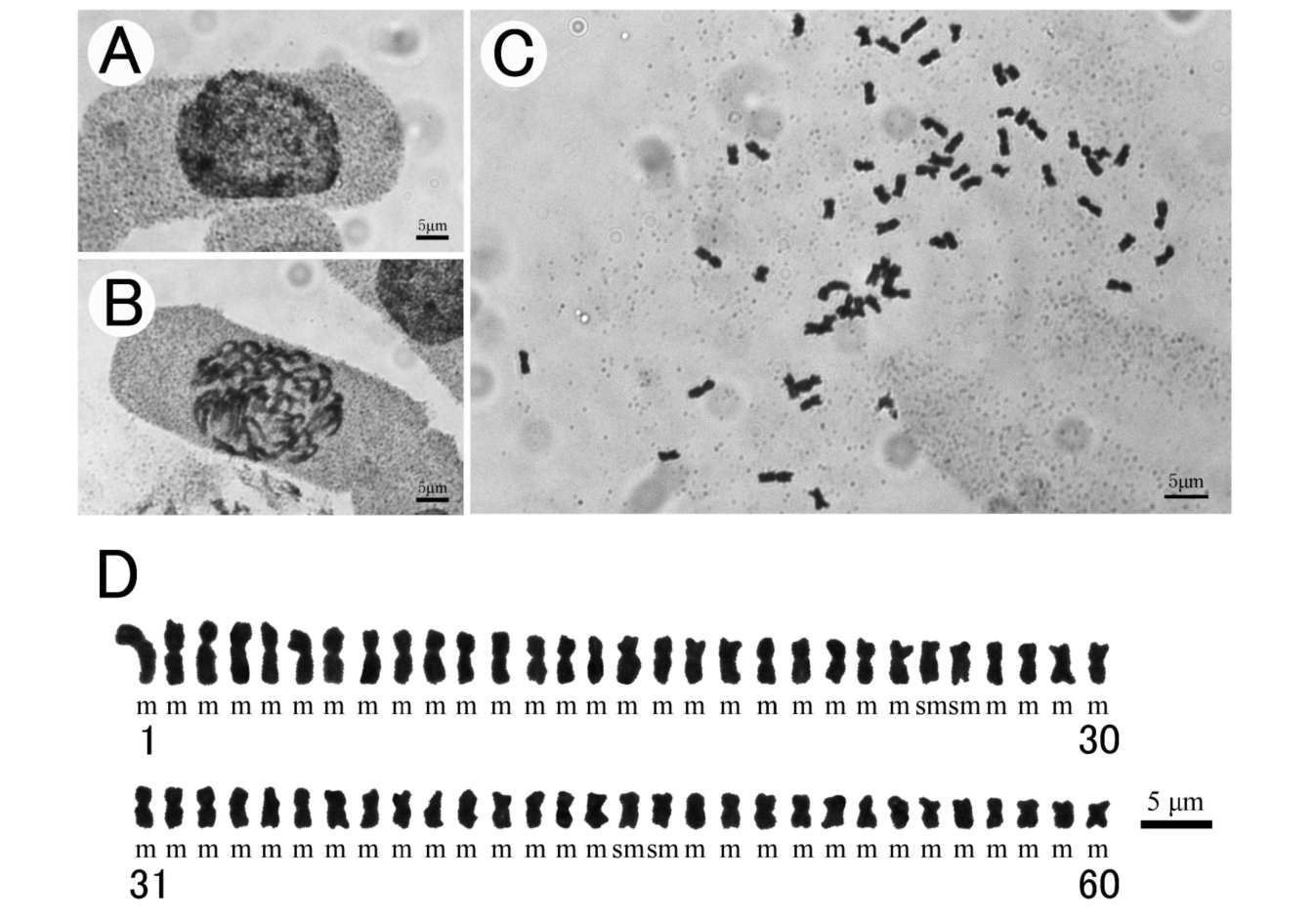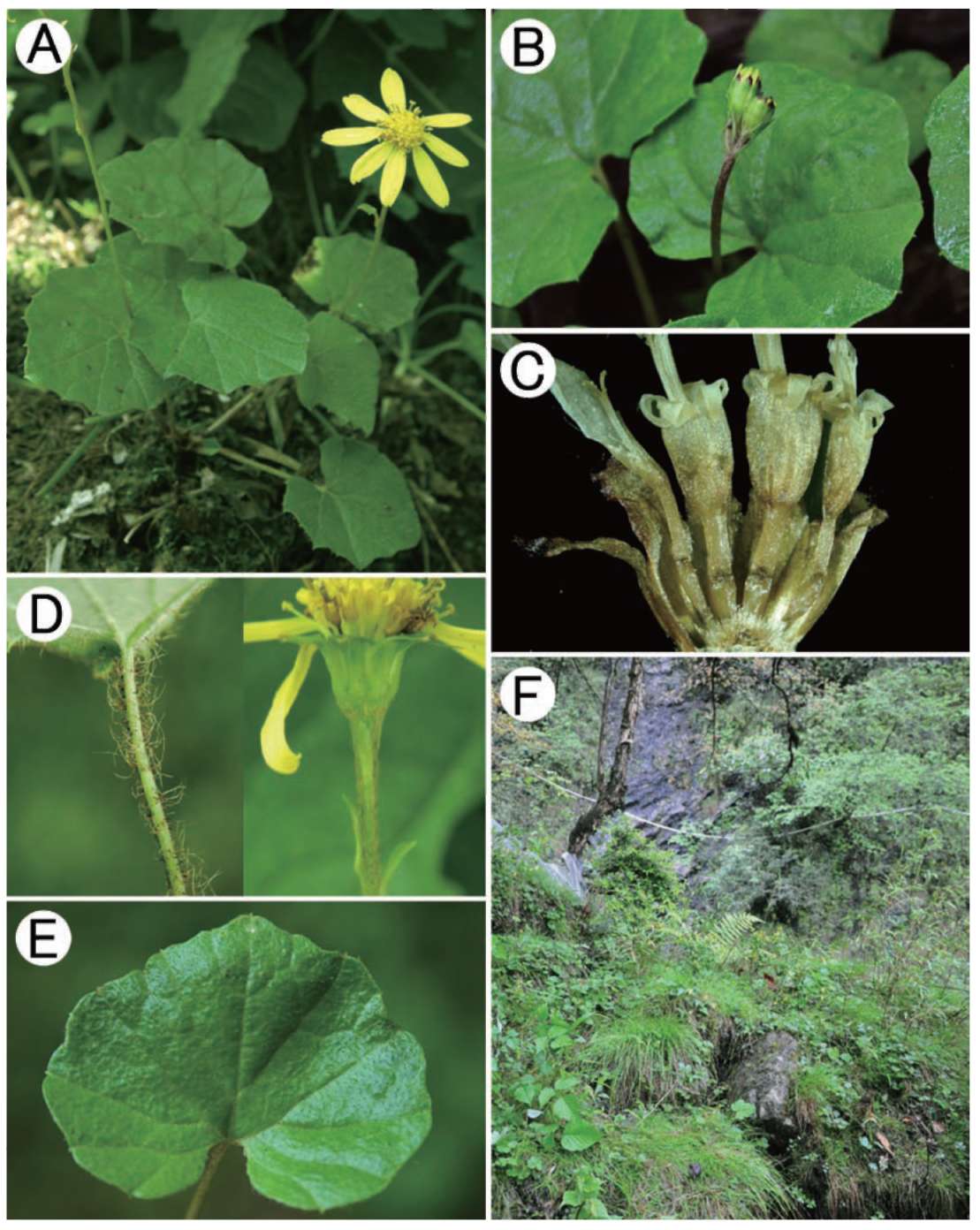|
|
|
|
|
|
|
|
|
|
|
|
|
Botanical Studies (2010) 51: 269-275.
|
|
|
|
|
|
|
|
|
|
|
|
|
|
Sinosenecio yilingii (Asteraceae), a new species from Sichuan, China
Ying LIU1'2 and Qin-Er YANG1*
!Key Laboratory of Plant Resources Conservation and Sustainable Utilization, South China Botanical Garden, Chinese Academy of Sciences, Xingke Road, Tianhe District, Guangzhou 510650, China
2State Key Laboratory of Systematic and Evolutionary Botany, Institute of Botany, Chinese Academy of Sciences, Beijimg 100093, China
(Received July 6, 2009; Accepted March 23, 2010)
ABSTRACT. Sinosenecio yilingii Y. Liu & Q. E. Yang, a new species from Sichuan, China, is described and illustrated. The new species is similar to S. homogyniphyllus (Cumm.) B. Nord., but differs in the taller stature, the leaves radical and cauline, often reniform, occasionally broadly ovate, glabrous or very sparsely pubescent above, the petioles proximally and the peduncle distally densely sericeous, the capitula solitary and terminal, and the phyllaries 11-13. Its somatic karyotype is formulated as 2n = 56m + 4sm, giving a chromosome number of 2n = 60. Photographs of both S. yilingii and S. homogyniphyllus, line drawings, distribution map, and light microscope (LM) microphotographs of floral characters of S. yilingii are provided.
Keywords: Asteraceae; Chromosome number; Karyotype; New species; Senecioneae; Sinosenecio yilingii.
|
|
|
|
|
|
|
|
INTRODUCTION
In the course of making a comprehensive survey of the specimens of the genus Sinosenecio B. Nord. (Senecioneae-Asteraceae) deposited in Chinese herbaria for the first author's Ph.D. project on the systematics and evolution of this genus, a fruiting collection, Gui-ling Chu 3052 (IBSC, PE) (Figure 1), made from Meili River, Baoxing County, Sichuan Province, China, caught our attention. This collection had been previously identified as S. homogyniphyllus (Cumm.) B. Nord., and cited under this name by Jeffrey and Chen (1984). Upon a closer examination, however, we found that the collection differs markedly from S. homogyniphyllus in having leaves radical and cauline (vs. radical), the petioles proximally and the peduncle distally densely sericeous (vs. yellowish-brown villous). In June 2007 and May 2009, we made two botanical expeditions to Baoxing County and collected successfully flowering and fruiting specimens of the plant in question. We found that the plant is similar to S. homogyniphyllus in posture and epappose achenes, but differs in the taller stature (10-40 cm vs. 10-25 cm), the leaves radical and cauline (vs. radical), often reniform, occasionally broadly ovate (vs. often broadly ovate-orbicular, occasionally reniform), glabrous or very sparsely pubescent above (vs. sparsely villous), the petioles proximally and the peduncle distally densely
|
|
|
|
|
Figure 1. Gui-ling Chu 3052 (PE), collected from Baoxing County, Sichuan, China. This collection, previously misidenti-fied as Sinosenecio homogyniphyllus, represents a new species, S. yilingii.
|
|
|
|
*Corresponding author: E-mail: qeyang@scib.ac.cn; Tel: 86-20-37094273; Fax: 86-20-37094273.
|
|
|
|
|
|
|
|
|
|
|
|
|
|
|
|
|
|
|
|
|
|
|
|
|
Botanical Studies, Vol. 51, 2010
|
|
|
|
|
|
|
|
sericeous (vs. yellowish-brown villous), the capitula always solitary and terminal (vs. solitary or several in terminal subumbelliform corymbs), and the phyllaries 11-13 (vs. 7-10). Therefore, we concluded that the plant represents a hitherto undescribed species.
NEW SPECIES
Sinosenecio yilingii Y. Liu & Q. E. Yang, sp. nov.― TYPE: CHINA. Sichuan, Baoxing County, Meili River, alt. ca. 2,200 m, stream side along margin of deciduous broad-leaved forests, 17 May 2009, Ying Liu & Tao
Deng 2009069 (holotype: IBSC; isotypes: HAST, PE).
藝林蒲兒根 Figures 2, 3
|
Habitu et pappo nullo species nova haec similis Sino-senecioni homogyniphyllo (Cumm.) B. Nord., sed planta altiore, 10-40 cm alta, cattle foliato, foliorum laminis reni-formibus vel interdum late ovatis, supra glabris vel inter-dum sparsissime pubescentibus, petiolis basi et pedunculo in superiore parte dense sericeo, capitulis singularibus, involucri phyllariis 11-13 differt.
Subscapigerous herb, stolons absent. Rhizomes 2-3 mm in diameter. Stems solitary or sometimes several, erect, 10-40 cm tall, simple, sparsely sericeous or later gla-brescent in the upper part, densely sericeous at the base. Leaves 3-6, radical and cauline, long-petiolate; lamina reniform or sometimes broadly ovate, 1.7-5.5 x 2-6.5 cm, palmately veined, margin repand or dentate with mucro-
|
|
|
|
|
|
|
|
|
|
|
|
|
|
|
|
Figure 2. Sinosenecio yilingii Y. Liu & Q. E. Yang. A, Habit; B, Base of petiole; C, Phyllary; D, Ray floret; E, Disc floret; F, Style-arms; G, Anther (From Ying Liu & Tao Deng 2009069 and Qin-er Yang, Qiong Yuan & Ying Liu 947, both at IBSC and PE).
|
|
|
|
|
|
|
|
|
|
|
|
|
|
|
|
|
|
|
|
|
|
|
LIU and YANG ― Sinosenecio yilingii, a new species from China
|
|
|
|
|
|
|
|
|
nulate teeth, apex obtuse or sometimes acute, base deeply cordate to cordate, subcoriaceous to membranous, green to dark green, nitid above, pale-green beneath, glabrous or sometimes very sparsely pubescent on both surfaces; petioles 4-9 cm long, sparsely sericeous or later glabres-cent in the upper part, densely sericeous at the base. Upper cauline leaves smaller, with shorter petioles. Capitula solitary, terminal; peduncle sparsely sericeous or later glabrescent in the lower part, densely sericeous in the upper part. Involucre obconic, ecalyculate, 7-10 x 5-7 mm. Phyllaries 11-13, uniseriate, oblong or oblong-lanceolate, 7-10 x 1.5-2.5 mm, apex acuminate or acute, subglabrous: apex fimbriate-ciliate, herbaceous, green. Ray florets ca. 13; corolla tube ca. 2.5 mm long, glabrous; rays yellow, oblong-elliptic, ca. 10 x 3 mm, apically 3-denticulate,
|
6-7-veined. Disc florets many; corolla ca. 4 mm long, tube ca. 3 mm long, limb campanulate; lobes ovate-lanceolate. Anthers ca. 2 mm long, base obtuse, appendages ovate-oblong. Style arms ca. 1 mm long, apex truncate. Achenes obovoid-cylindrical, 1.5 mm long, smooth, glabrous. Pappus absent.
Additional specimens examined. CHINA: Sichuan, Baoxing County, Meili River, in woods, 30 Jun 1936, Gui-ling Chu 3052 (BM, IBSC, PE); the same locality, alt. ca. 2100 m, stream side along margin of deciduous broad-leaved forests, 26 June 2007, Qin-er Yang, Qiong Yuan & Ying Liu 947 (IBSC, PE).
Etymology. This species is named in honor of Professor Yi-Ling Chen, Institute of Botany, Chinese Academy of
|
|
|
|
|
|
|
|
|
|
|
|
|
|
|
|
Figure 3. Sinosenecio yilingii Y Liu & Q. E. Yang. A, Posture; B, Capitulum; C, Florets; D, Trichomes of petiole (left) and peduncle (right); E, Leaves, abaxial side (left) and adaxial side (right); F, Habitat (All from Ying Liu & Tao Deng 2009069, HAST, IBSC, PE).
|
|
|
|
|
|
|
|
|
|
|
|
|
|
|
|
|
|
|
|
|
|
|
|
|
Botanical Studies, Vol. 51, 2010
|
|
|
|
|
|
|
|
Sciences, who has made outstanding contributions to the taxonomy of the Chinese Asteraceae.
Phenology. Flowering from May to June; fruiting from June to July.
Distribution, habitat and status. Sinosenecio yilingii is currently known only from one population found in a ravine in Baoxing County, Sichuan Province, China (Figure 4), growing in grasses or on rocks of streamside along margin of deciduous broad-leaved forests at an altitude of ca. 2,200 m above the sea level. If this is truly the only population, then according to the IUCN red list categories and criteria, version 3.1 (IUCN, 2001), S. yilingii should be categorized as a critically endangered species (CR). Perhaps the most serious threat to the species' survival lies in the ongoing habitat destruction through mining.
Floral micromorphological characters. For observation of the anther endothecial cell wall thickenings and filament collar of Sinosenecio yilingii, heads were boiled in distilled water for 3 min, and then fixed with Carnoy I (glacial acetic acid: absolute ethanol = 1: 3). Mature disc florets removed from the fixed heads were dehydrated in 70% ethanol for 30 min and then in 99% ethanol for 1 h before they were treated with 5% NaOH overnight. The anther tissue was isolated from the florets on the slide, flooded with 50% glycerol and a cover slip was applied. Samples were then examined at 200x (filament collar) and 400x (endothecial cell wall thickenings) magnification by light microscopy and photographed.
The endothecial cell wall thickenings in Sinosenecio yilingii were strictly polar (Figure 5A), a character found to occur in some members of Sinosenecio sect. Sinosenecio (Jeffrey and Chen, 1984). In the members of Sinosenecio sect. Phyllocaulon C. Jeffrey & Y. L. Chen, the endothecial cell wall thickenings are radial or radial and polar (Jeffrey and Chen, 1984; Zhang et al., 2008; Liu et al., 2009). As indicated in Figure 5B, its filament collar consisted of uniformly sized cells, conforming to one of the diagnostic characters of this genus (Nordenstam, 1978;
Jeffrey and Chen, 1984).
|
|
|
|
|
Figure 5. Anther endothecial cell wall thickenings (A) and filament collar (B) of Sinosenecio yilingii. A. Polar and radial thickenings; B, Uniformly sized cells (All from Qin-er Yang, Qiong Yuan & Ying Liu 947, IBSC, PE).
|
|
|
|
Chromosome cytology. For chromosome observation, root tips were pretreated with 0.1% colchicine for 3 h before being fixed in Carnoy I (glacial acetic acid: absolute ethanol = 1: 3), then macerated in a 1:1 mixture of 45% acetic acid and 1 M HCl at 60°C for 3 min, stained and squashed in Carbol fuchsin.
In the interphase nuclei, a few darkly stained condensed bodies were observed, but their boundaries were not clear, because the other part was also stained fairly well but unevenly (Figure 6A). The prophase chromosomes displayed a distinctly continuous condensation pattern (Figure 6B). The metaphase chromosomes were counted to be 2n = 60 (Figure 6C). Based on the nomenclature of chromosomes of Levan et al. (1964), Sinosenecio yilingii had 56 median- centromeric (m) and 4 submedian-centromeric (sm) chromosomes (Figure 6D), i.e. 2n = 60 = 56m + 4sm. The chromosomes changed gradually from the largest to the smallest in size, and the karyotype was highly symmetrical. The chromosome number 2n = 24 reported by Liu (1999) for S. homogyniphyllus, the close relative of S. yilingii, may represent a wrong count, most likely owing to misidentification of material, as the material examined by him was obtained as a gift from an anonymous person. We have re-examined the chromosomes of S. homogyniphyllus and revealed the number as 2n = 60. The results of a comprehensive survey of the chromosome numbers in the genus Sinosenecio will be reported in a separate paper (Ying Liu & Qin-er Yang, in prep.).
Notes. Sinosenecio yilingii can be readily referred to subsect. Phalacrocarpa C. Jeffrey & Y. L. Chen, sect. Sinosenecio, based on its strictly polar anther endothecial cell wall thickenings and epappose achenes. Its subscapigerous posture and epappose achenes, at first glance, are strongly reminiscent of S. homogyniphyllus (Figure 7), but upon a closer examination they are readily distinguishable from each other by a series of significant characters as aforementioned (also see Table 1). In the same ravine where S. yilingii was collected, we also found
|
|
|
|
|
|
|
|
Figure 4. Distribution of Sinosenecio yilingii (▲).
|
|
|
|
|
|
|
|
|
|
|
|
|
|
|
|
|
|
|
|
|
|
LIU and YANG ― Sinosenecio yilingii, a new species from China 273
|
|
|
|
|
|
|
|
|
|
|
|
|
|
|
|
Figure 6. Interphase nucleus (A), mitotic prophase (B), metaphase (C, 2n = 60) chromosomes and karyotype (D) of Sinosenecio yilingii (All from Qin-er Yang, Qiong Yuan & Ying Liu 947, IBSC, PE).
|
|
|
|
|
|
|
|
|
|
|
|
|
|
|
|
Table 1. Comparison of Sinosenecio yilingii and S. homogyniphyllus.
|
|
|
|
|
|
|
|
|
|
|
|
|
|
|
|
|
Herb with radical and cauline leaves
|
|
|
|
|
|
Often reniform, occasionally broadly ovate, margin repand or dentate with mucronu-late teeth
|
Often broadly ovate-orbicular, occasionally reniform, margin repand-dentate or suben-tire with mucronulate teeth
|
|
|
|
|
Glabrous or very sparsely pubescent above
|
|
|
|
|
Pubescence of petiole and peduncle
|
Petiole proximally and peduncle distally densely sericeous
|
Petiole and peduncle more or less yellowish-brown villous
|
|
|
|
|
|
|
|
|
|
|
|
|
|
|
|
|
|
Absent, rarely pappus-hairs several
|
|
|
|
|
|
|
|
|
|
|
|
|
|
|
|
|
Shady places along forest margin or on streamside rocks, 2,100-2,200 m a.s.l
|
On rocks, in shady places and in forests, 1,300-2,900 m a.s.l
|
|
|
|
Geographical distribution
|
Restricted to Baoxing County, W Sichuan
|
Widely distributed in W Sichuan
|
|
|
|
|
|
|
|
|
|
|
|
|
|
|
|
|
|
|
|
|
|
|
|
|
|
|
|
|
|
Botanical Studies, Vol. 51, 2010
|
|
|
|
|
|
|
|
|
|
|
|
|
|
|
|
Figure 7. Sinosenecio homogyniphyllus (Cumm.) B. Nord. A, Posture; B, Capitula; C, Florets; D, Trichomes of petiole (left) and peduncle (right); E, Leaf; F, Habitat (All from Qin-er Yang, Qiong Yuan & Ying Liu 946, PE).
|
|
|
|
|
|
|
|
a population of S. homogyniphyllus. Interestingly, the plant individuals of S. yilingii usually grew in shady places along forest margin or on streamside rocks, flowering from May to June, while those of S. homogyniphyllus preferred more open sunny places, flowering from June to July. It seems that at least in this ravine these two species have achieved their reproductive isolation through the differences in their flowering time and habitat preference. As such, it is not surprising that we did not observe any possible hybrids between S. yilingii and S. homogyniphyllus in the ravine.
In their infrageneric division of the genus Sinosenecio,
|
Jeffrey and Chen (1984) used the presence or absence of cauline leaves as the only character to distinguish ser. Elati C. Jeffrey & Y. L. Chen from ser. Scaposi C. Jeffrey & Y. L. Chen under subsect. Phalacrocarpa, with the former series characterized by the presence of cauline leaves, and the latter by the absence of cauline leaves. The discovery of S. yilingii has resulted in the collapse of this distinguishing character at series level. This species, although having cauline leaves, seems to be much more closely related to S. homogyniphyllus within ser. Scaposi than to the members within ser. Elati. The strictly polar
|
|
|
|
|
|
|
|
|
|
|
|
|
|
|
|
|
|
|
|
|
|
|
LIU and YANG ― Sinosenecio yilingii, a new species from China
|
|
|
|
|
|
|
|
|
anther endothecial cell wall thickenings and chromosome number 2n = 60 of S. yilingii also lend strong support to its placement together with S. homogyniphyllus in the same series. All the species thus far examined in ser. Elati were found to have polar and radial anther endothecial cell wall thickenings and the chromosome number 2n = 48 (Zhang
et al., 2008; Liu et al., 2009; Ying Liu & Qin-er Yang,
unpublished data).
Acknowledgments. We are very grateful to Dr. B. Nordenstam and Dr. Thomas G. Lammers for their invaluable comments on the manuscript. We thank Mr. Sun Ying-bao for making the drawing, and Mr. Deng Tao for his help in the field work. This work was supported by the Knowledge Innovation Project of the Chinese Academy of Sciences (KSCX2-YW-Z-0918, KZCX2-YW-415).;
LITERATURE CITED
Chen, Y.L. 1999. Sinosenecio B. Nord. In Anonymous (ed.), Flora Reipublicae Popularis Sinicae 77(1). Science Press, Beijing, pp. 101-141.
|
IUCN. 2001. IUCN Red List Categories ad Criteria, v.3.1.
Gland/Cambridge: IUCN Species Survival Commission.
Jeffrey, C. and Y.L. Chen. 1984. Taxonomic studies on the tribe Senecioneae (Compositae) of Eastern Asia. Kew Bull. 39: 205-446.
Levan, A., K. Fredga, and A.A. Sandberg. 1964. Nomenclature for centromeric postion on chromosomes. Hereditas 52:
201-220.
Liu, J.Q. 1999. Systematics of the Tribe Senecioneae subtribe Tussilagininae (Asteraceae) of the Eastern Asia. Ph.D. thesis, Institute of Botany, Chinese Academy of Sciences, Beijing.
Liu, Y. , G. X. Chen, and Q. E. Yang. 2009. Sinosenecio baojingensis (Asteraceae), a new species from Hunan, China. Bot. Stud. 50: 107-113.
Nordenstam, B. 1 978. Taxonomic studies on the tribe Senecioneae (Compositae). Opera Bot. 44: 1-84.
Zhang, D. G. , Y. Liu, and Q. E. Yang. 2008. Sinosenecio jishouensis (Compositae), a new species from north-west
Hunan, China. Bot. Stud. 49: 287-294.
|
|
|
|
|
|
|
|
中國四川產蒲兒根屬一新種:藝林蒲兒根
劉 瑩1'2 楊親二1
1中國科學院植物資源保護與可持續利用重點實驗室(華南植物園)
2中國科學院植物研究所系統與進化植物學國家重點實驗室
本文描述了中國四川產蒲兒根屬一新種:藝林蒲兒根<:Siinosmccio yilingii Y. Liu & Q. E. Yang)。
本新種與腎葉蒲兒根[Sinosenecio homogyniphyllus (Cumm.) B. Nord.]相似,但以植株較高,葉基生以及
莖生,通常腎形,偶爾闊卵形,葉片上表面無毛或稀被柔毛,葉柄基部與花序梗上部密被絲狀毛,頭
狀花序單生,總苞片11-13而與後者相區別。其體細胞染色體數目為 2n = 60 。核型公式為 2n = 56 m +
4 sm 。本文提供了藝林蒲兒根以及腎葉蒲兒根的彩色圖版、藝林蒲兒根的線繪圖、花部微觀性狀的光鏡
照片以及地理分佈圖。
關鍵詞:菊科;染色體數目;核型;新種;千里光族;藝林蒲兒根。
|
|
|
|
|
|
|
|
|
|
|
|
